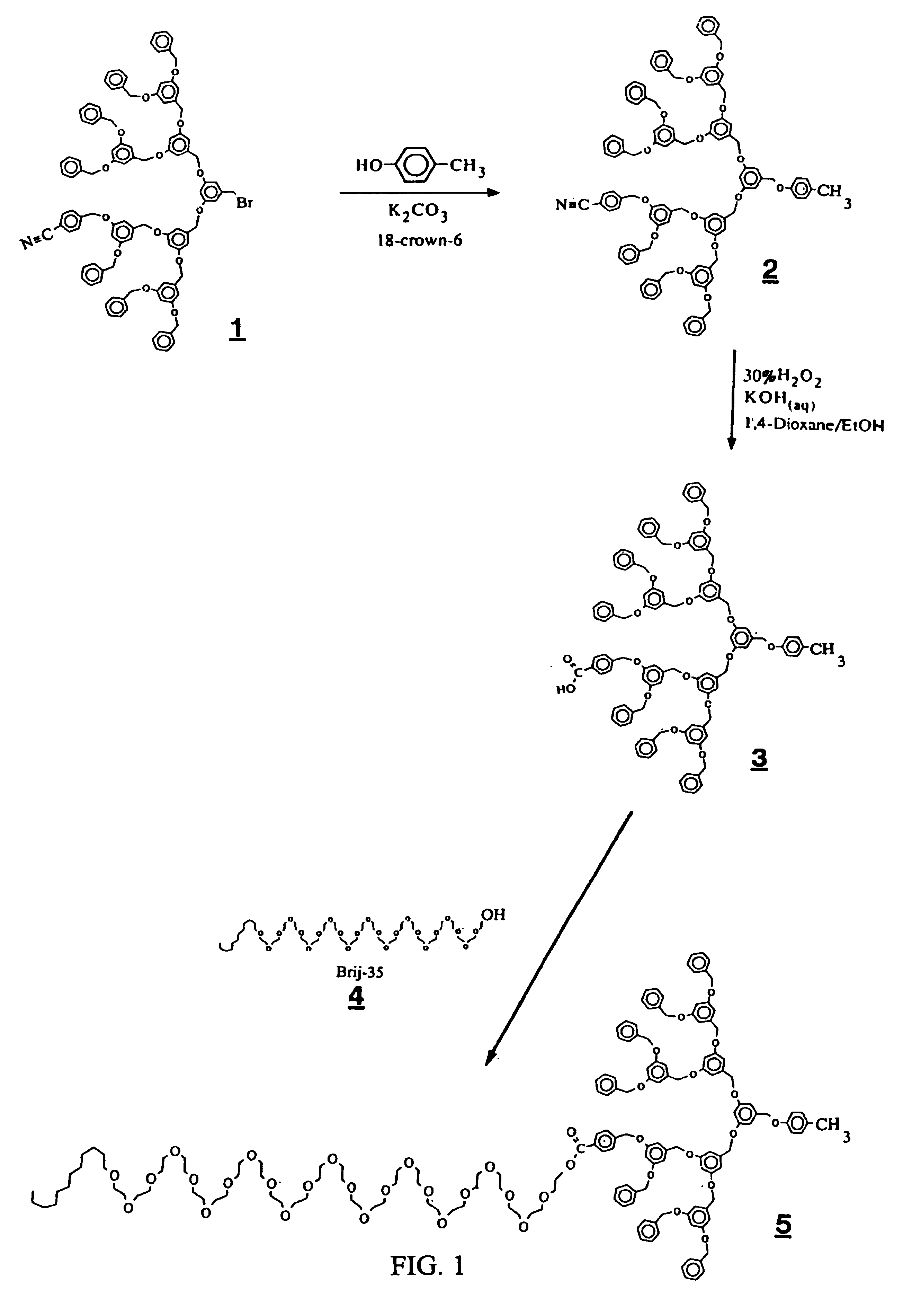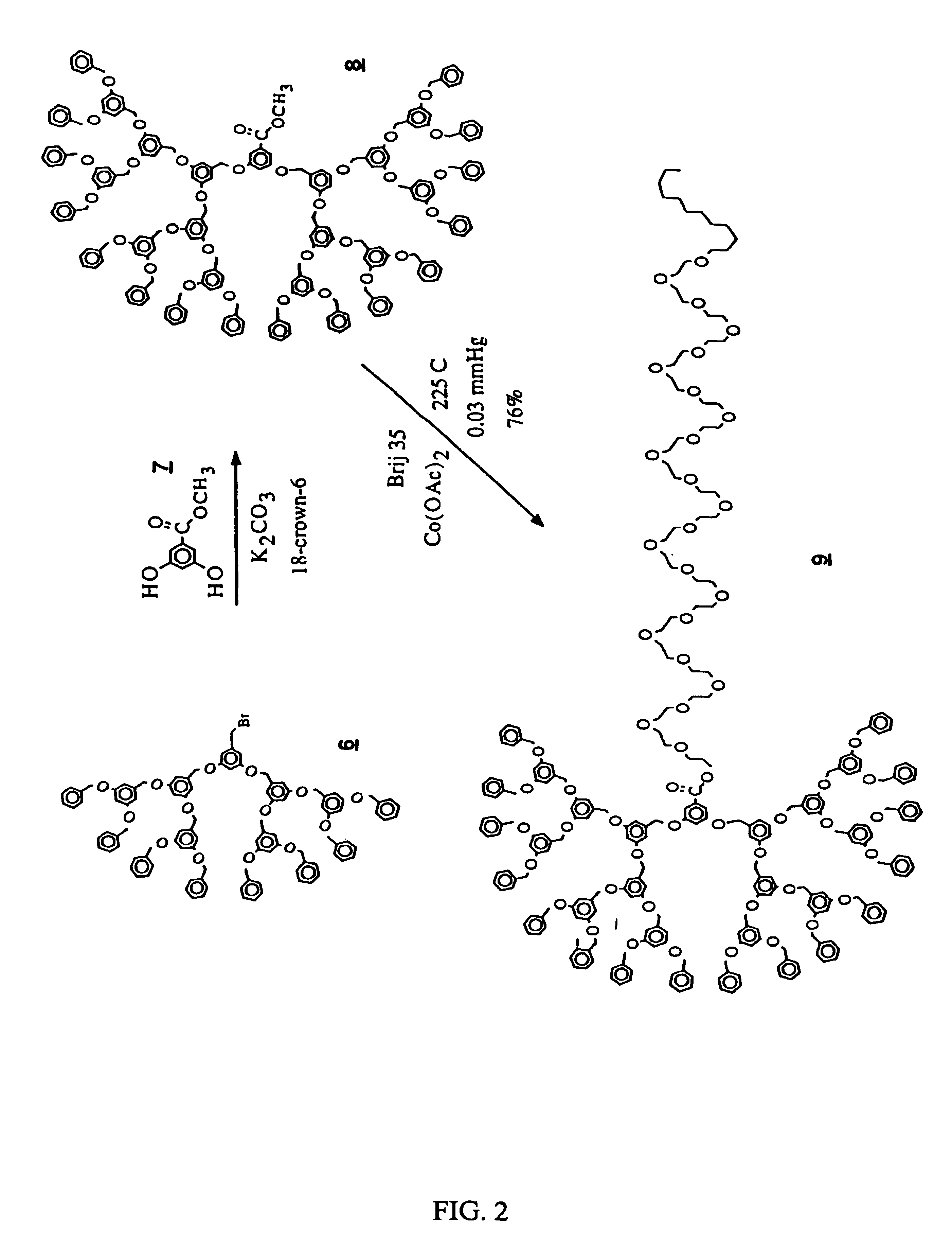Dendritic based macromolecules
a macromolecule and dendrite technology, applied in the field of dendrite molecules, can solve the problems of not being able to produce dendrite molecules having a molecular weight greater than 790, and the disclosure of such structures is, however, very limited
- Summary
- Abstract
- Description
- Claims
- Application Information
AI Technical Summary
Benefits of technology
Problems solved by technology
Method used
Image
Examples
example 1
Preparation of Peripherally Attached Poly(ethylene glycol)-Dendrimer Block Copolymers (Kite Shape, Scheme II) (FIG. 1)
A. Preparation of CN—[G-3]-OPhCH3: Compound 2
[0043]A mixture of CN—[G-3]—Br (Compound 1) (5.0 g, 3.0 mmol), p-cresol (0.39 g, 3.6 mmol), potassium carbonate (0.5 g, 3.6 mmol), and 18-crown-6 (0.15 g, 0.57 mmol) in acetone (50 mL) was heated at reflux under N2 for 12 h. Dendrimer CN—[G-3]—Br is prepared by the reaction procedure of U.S. Pat. No. 5,041,516. The specific compound is compound 27 on page 1073 of Wooley et al., J. Chem. Soc., Perkin Trans, 1, 1991, 1059. The reaction mixture was evaporated to dryness, and the residue was partitioned between methylene chloride / water. The aqueous layer was extracted with CH2Cl2 (3×25 mL) and the combined CH2Cl2 extracts were dried over MgSO4 and concentrated in vacuo. The product was purified by flash chromatography eluting with 5% hexanes / CH2Cl2 to give the title compound 2 as a colorless glass: yield 92%.
B. Preparation of ...
example 2
[0046]Preparation of Focal Point Attached Poly(ethylene glycol)-Dendrimer Block Copolymers via Esterification Reaction (Kite Shape, Scheme I) (FIG. 2)
A. Preparation of [G-4]—COOMe: Compound 8
[0047]A mixture of [G-3]—Br 6 (2.35 g, 1.42 mmol, 2.1 equiv.), methyl-3,5-dihydroxybenzoate (0.114 g, 0.679 mmol), potassium carbonate (0.21 g, 1.5 mmol, 2.2 equiv.) and 18-crown-6 (0.04 g, 0.15 mmol, 0.2 equiv.) in acetone was heated at reflux, under N2, for 16 h. The starting compound 6 may be prepared as shown in J. Am. Chem. Soc., 112, 1990, 7638 page 7646, compound #12. The solvent was removed under reduced pressure and the residue was partitioned between water and methylene chloride. The aqueous layer was extracted with CH2Cl2 and the combined CH2Cl2 extracts were dried over MgSO4 and evaporated to dryness. The product 8 was purified by flash chromatography eluting with CH2Cl2 to give [G-4]—COOMe as a colorless glass: yield 87%.
B. Preparation of [G-4]—COO(CH2CH2O)23C12H25: Compound 9
[0048]...
example 3
Preparation of Focal Point Attached Poly(ethylene glycol)-Dendrimer Block Copolymers via Ether-forming Reaction (Kite Shape, Scheme I) (FIG. 3)
[0049]To a mixture of [G-4]—Br 10 (2.0 g, 0.60 mmol, 1 equiv.) (prepared as in J. Am. Chem. Soc., 1990, 112, 7638, Compound 14 at page 7646), and BrijR35 (0.60 g, 0.50 mmol, 0.8 equiv.) in THF at room temperature was added sodium hydride (0.06 g, 2.5 mmol, 4.2 equiv.). The reaction mixture was stirred at room temperature under N2. The progress of the reaction was monitored by size exclusion chromatography, which showed progressive disappearance of the starting materials. After 24 hours, the reaction mixture was added dropwise to a mixture of acetone and methanol (1:3) and processed in a standard fashion as described by Itsuno et al., Polym. J., 1991, 23, 1045) to afford the desired product 11 in 79% yield.
PUM
| Property | Measurement | Unit |
|---|---|---|
| molecular weight distribution | aaaaa | aaaaa |
| temperature | aaaaa | aaaaa |
| shape | aaaaa | aaaaa |
Abstract
Description
Claims
Application Information
 Login to View More
Login to View More - R&D
- Intellectual Property
- Life Sciences
- Materials
- Tech Scout
- Unparalleled Data Quality
- Higher Quality Content
- 60% Fewer Hallucinations
Browse by: Latest US Patents, China's latest patents, Technical Efficacy Thesaurus, Application Domain, Technology Topic, Popular Technical Reports.
© 2025 PatSnap. All rights reserved.Legal|Privacy policy|Modern Slavery Act Transparency Statement|Sitemap|About US| Contact US: help@patsnap.com



